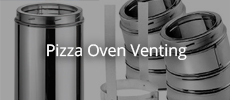Re: 36" Pompeii in DC
There is no need to use stainless. Mild steel works just fine, and is probably cheaper than SS needles. It will cost you less than $30, and you can probably scrounge something even cheaper
X
-
Re: 36" Pompeii in DC
Ryan,Originally posted by rsandler View PostChip,
I'm not trying to make my life difficult, I'm just trying to figure something out that will work, and/or learn why alternatives won't work. I'd love to have a nice, sturdy metal door like yours (exactly like yours, in fact; it would be great to have 4" of insulation). But more insulation costs $$, stainless sheet costs $$ and is a pain to acquire, the tools to work with stainless (a welder or cobalt drill bits) cost $$, and I'm already cringing at how much $$ I've sunk into just making a bloody door. That, and from my previous attempts I seem to be fairly incompetent when it comes to working with metal. I can get a pound of SS needles online for around $15, and at least with mortar/concrete I kind of know what I'm doing.
If it's infeasible, because SS needles won't hold it together, or the edges will chip excessively, fine. I'll shell out for stainless, and try to figure out a way to assemble it that I'm less likely to screw up. I'm just trying to figure out if that's so, and why, just to fill out my own scanty knowledge.
FWIW, Tscarborough had a concrete door, at least as of a couple years ago: http://www.fornobravo.com/forum/9/tw...html#post91821 So if it's totally crazy, at least it's not uniquely crazy
-Ryan
Become a scrounger, Craigslist, garage sale, Thrift store etc you should be able to locate a SS Kitchen Trash can, old stainless grill door that the internal parts have gone bad on, non working stainless fridge or dishwasher, all good sources of nice thin stainless. Check out appliance stores that take the old ones from peoples homes, they often scrap this stuff out and will give you a door or panel for next to nothing.
I looked on DC/Craigslist for ====FREE=== 2 Stainless Gas Grills, 1 dishwasher, and one microwave. All good sources of stainless sheet metal.
There may be other good sources of thin stainless out there and if anyone has any ideas please chime in.
As far as cutting and fabricating. A thin metal cutting wheel on an angle grinder is all i used. I bent the metal with pliers, a hammer and blocks of wood. Drilling does not require cobalt bits. TI coated - the gold ones work just fine, and pop rivets work well but are not required you can use stainless sheet metal screws, you already have 4 bolts to hold it together.
Chip1 PhotoLast edited by mrchipster; 05-21-2013, 08:02 AM.
Leave a comment:
-
Re: 36" Pompeii in DC
Chip,
I'm not trying to make my life difficult, I'm just trying to figure something out that will work, and/or learn why alternatives won't work. I'd love to have a nice, sturdy metal door like yours (exactly like yours, in fact; it would be great to have 4" of insulation). But more insulation costs $$, stainless sheet costs $$ and is a pain to acquire, the tools to work with stainless (a welder or cobalt drill bits) cost $$, and I'm already cringing at how much $$ I've sunk into just making a bloody door. That, and from my previous attempts I seem to be fairly incompetent when it comes to working with metal. I can get a pound of SS needles online for around $15, and at least with mortar/concrete I kind of know what I'm doing.
If it's infeasible, because SS needles won't hold it together, or the edges will chip excessively, fine. I'll shell out for stainless, and try to figure out a way to assemble it that I'm less likely to screw up. I'm just trying to figure out if that's so, and why, just to fill out my own scanty knowledge.
FWIW, Tscarborough had a concrete door, at least as of a couple years ago: http://www.fornobravo.com/forum/9/tw...html#post91821 So if it's totally crazy, at least it's not uniquely crazy
-Ryan
Leave a comment:
-
Re: 36" Pompeii in DC
You really have a fixation on trying to make your life more difficult, .75 inches of home brew will be very heavy, still very brittle at the edges, and not hold up over time. ie why not make residential doors out of concrete? Well because it is heavy and brittle and do not retain fasteners well under stress of movement. Moving things are rarely made from concrete. Usualy because of flexibility, moving items are made from wood, metal or plastic. And tempered glass is flexible just in case you thought of that as brittle. A thin sheet of stainless will be light, durable, heat resistant, non corrosive, flexible, and lastly will work.Originally posted by rsandler View PostSo, humor me for a second here. I get that mortar will not make a very good bond with the insulation and aluminum, and so plain mortar would eventually crack and fall right off, same as the cement board is doing. But if I mix SS needles in, preventing it from cracking, and the SS nuts are on the ends of the bolts, where is it going to go?
Is my faulty assumption is that even with SS needles, 1/2-3/4" of homebrew will still crack, or is it something else that I'm missing?
But please, if you need to try it, go right ahead. And let us know how many cycles your concrete door lasts.
My metal door is over a year old and works just as well today as the day it was built, I have dropped it several times and on one occasion I even bent one of the corners, a pliers fixed it back to it's original shape, and have on average 3 firings a month and use it for 3-4 meals a week, each meal requires the door to be in and out several times.
Best of luck.
Chip
Leave a comment:
-
Re: 36" Pompeii in DC
So, humor me for a second here. I get that mortar will not make a very good bond with the insulation and aluminum, and so plain mortar would eventually crack and fall right off, same as the cement board is doing. But if I mix SS needles in, preventing it from cracking, and the SS nuts are on the ends of the bolts, where is it going to go?Originally posted by brickie in oz View PostYou are correct.
The stuff will just fall off after a while.
Is my faulty assumption is that even with SS needles, 1/2-3/4" of homebrew will still crack, or is it something else that I'm missing?
Leave a comment:
-
Re: 36" Pompeii in DC
You are correct.Originally posted by rsandler View Post
This is surely a terribly idea for some reason(s); I trust you all will tell me why?
The stuff will just fall off after a while.
Leave a comment:
-
Re: 36" Pompeii in DC
Hmm, no one responded to the previous post. Is that an indication that it actually isn't all that crazy, or (more likely) that it's such an incredibly terrible idea that I have stunned you all into silence?
More likely, I will track down some stainless sheet/plate and use that. Maybe get two and put one between the outer cement board and the wood.
Leave a comment:
-
Re: 36" Pompeii in DC
Riffing off of the end of the previous post, how about this for crazy idea #73:
What if I were to remove the remaining cracked cement board, while leaving the bolts and nuts in place and protruding ~1/2 inch from the insulation. Then I mix up a batch of homebrew mortar laced with stainless steel fibers/needles, and spread a 1/2-3/4 inch thick layer on the inside of the door. In principle, you'd have something like the homebrew equivalent of a layer of reinforced, dense castable refractory, anchored to the rest of the door by the protruding stainless steel bolts and nuts. In addition to sealing in the insulation and resisting heat, it would have some thermal mass to reflect heat back into the oven for baking bread.
This is surely a terribly idea for some reason(s); I trust you all will tell me why?
Leave a comment:
-
Re: 36" Pompeii in DC
Certainly; I meant "so far" and "in relative terms". I need to come up with a solution for that sooner or later (or else I'll need to come up with a new piece of wood!), but it is not a good stiff shake away from total destruction.Originally posted by deejayoh View Postbingo!
BTW, your wood face not really holding up, it is slowly turning into charcoal.
So, supposing I do that, what gauge am I looking for and how do I drill it? The trouble I had with my door mark I (with aluminum back and front), is that the aluminum warped under the heat and, lacking much in the way of rigidity, failed to really hold the edge in place. On the other hand, I could drill it with a standard drill bit and some persistance. I'm guessing that stainless, especially stainless thick enough to be relatively rigid, will not be so easy. I suppose, since my new aluminum edge piece has a full set of tabs bent around the insulation, I could use aluminum go for rivets this time, although I'm somewhat disinclined to do so.I agree stainless is ideal, un galvanized steel second and then aluminum.
I might try applying mortar as a temporary quick-fix; given that the inside of the door needs to withstand heat but isn't getting much physical punishment, perhaps it would hang in there for a bit?
Leave a comment:
-
Re: 36" Pompeii in DC
I agree stainless is ideal, un galvanized steel second and then aluminum.Originally posted by deejayoh View Postbingo!
I doubt homebrew will hold up either. It has no shear strength, it will likely crack and fall off too.
Find a piece of scrap metal - preferably steel - and cut it with a jigsaw blade.
BTW, your wood face not really holding up, it is slowly turning into charcoal.
The cement board will be temporary no matter what you do.
A cutoff wheel on an angle grinder also works well for cutting curves on sheet metal.
I agree with DJ a full burn on the outer surface of the door is just a matter of time.
Chip
Leave a comment:
-
Re: 36" Pompeii in DC
bingo!Originally posted by rsandler View PostIs cement board not suitable for these temperatures?
I doubt homebrew will hold up either. It has no shear strength, it will likely crack and fall off too.
Find a piece of scrap metal - preferably steel - and cut it with a jigsaw blade.
BTW, your wood face not really holding up, it is slowly turning into charcoal.
Leave a comment:
-
Re: 36" Pompeii in DC
Ironically, the wood is holding up so far, even after two long, hot burns for a pizza party this weekend (a pre-heat the day before, then a long fire the day of). The cement board, not so much :P

Not sure what happened here; some chips of cement board had broken off previously and somehow wedged between the inner piece and the insulation, forcing the board away from the insulation. When I tried to fish the bits out last week, the board cracked a little bit. This weekend, I turned the door upside down to try to shake the bits out, and the sections of board cracked and fell off instead. The top piece that's cracked in the picture broke off shortly after.
What happened here? The cracks run between the bolts (and the top bolts are still partly holding the board on, a result). Did I tighten the bolts too much? Is cement board not suitable for these temperatures? The cement board-CalSil sandwich is what FB recommends in the Pompeii plans, though it seems that hardly anyone does it. Was the board just damaged, and once it chipped and the chips got wedged into it, the thing was doomed?
More to the point, how do I fix this thing? Start over? Just replace the inner board, don't tighten the bolts as much? Cover the exposed area with homebrew mortar? Could also parge the whole surface with homebrew, I suppose. I still have a bunch pre-mixed homebrew sitting in my garage. Just leave it? The insulation is still mostly covered by the aluminum tabs, the tabs are held down by the remaining cement board, and the bolts continue to hold it all together...so far.
Leave a comment:
-
Re: 36" Pompeii in DC
Be prepared for it to burn; char will easily turn to burn at some point. And highly likely after placing the door on after a long hot burn like a large pizza party.Originally posted by rsandler View PostYeah; I guess that's a good start for where the door may not be sealing well. Hopefully it doesn't do much more than char.
I placed my decorative wood face on metal and cut it back so it is protected by the insulation layer and metal
Note that I still get heat coming thru the door and heating the area around the handles. The door is filled with 4 inches of ceramic board. The handle supports do go all the way thru to the interior so there is some heat loss there. Something I will fix at some point.
Chip1 PhotoLast edited by mrchipster; 05-03-2013, 07:41 AM.
Leave a comment:
-
Re: 36" Pompeii in DC
Yeah; I guess that's a good start for where the door may not be sealing well. Hopefully it doesn't do much more than char.Originally posted by mrchipster View PostLooks like the wood is getting a little hot near the top and lower corner...
Chip
Leave a comment:
-
Re: 36" Pompeii in DC
Looks like the wood is getting a little hot near the top and lower corner...
ChipLast edited by mrchipster; 05-03-2013, 06:39 AM.
Leave a comment:





Leave a comment: